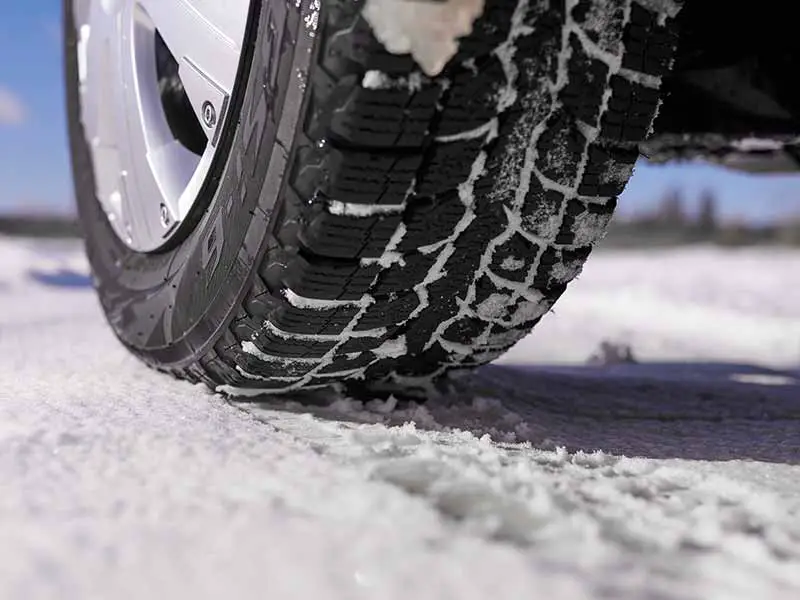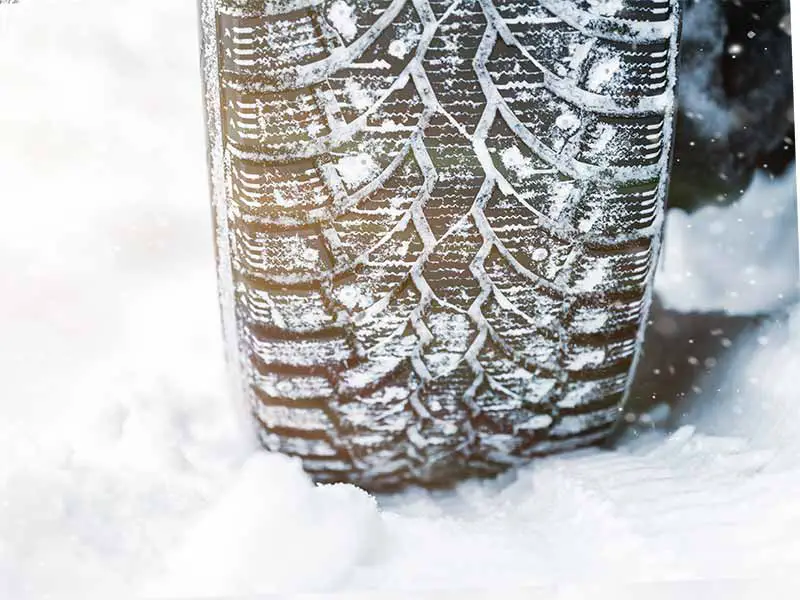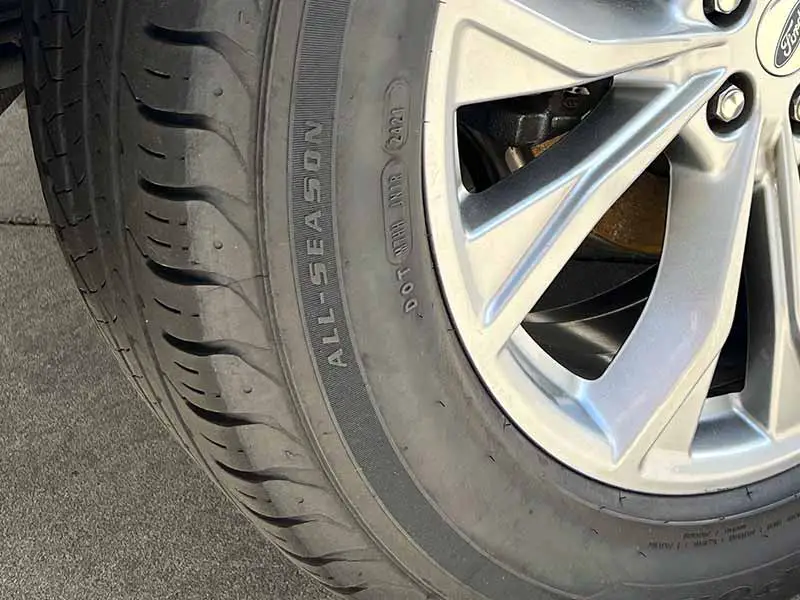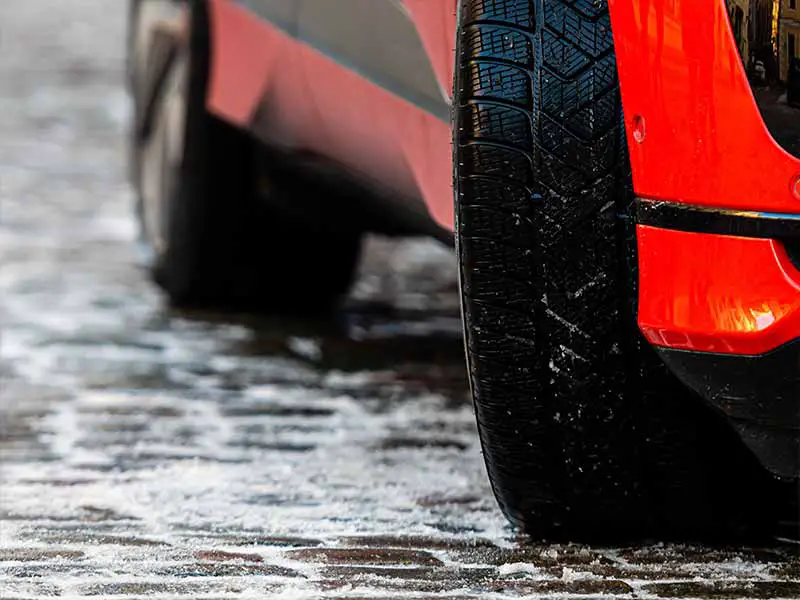Winter is coming, and you’re eyeing those sleek, low profile tires, imagining how cool they’d look on your car. But wait—before you make that purchase, have you considered how they’ll perform in the snow?
Are Low Profile Tires Good In Snow?
Low profile tires, which have shorter sidewalls, are not inherently bad for snow driving based on sidewall height alone. However, they are often performance-oriented with a wider footprint, which can reduce traction and make them less suitable for driving in snowy and icy conditions.
In this article, we’ll dive deep into the world of low profile and regular tires, exploring their differences, performance, and impact on fuel efficiency. We’ll also discuss the science of traction and why it’s crucial for winter driving, helping you make an informed decision for the snowy months ahead.
Let’s take a closer look.

What Are Low Profile Tires?
Low profile tires are a type of tire that have a shorter sidewall compared to their width. This makes them look “flatter” and “wider” than regular tires. The sidewall is the part of the tire that connects the tread (the part that touches the road) to the wheel.
In technical terms, the “aspect ratio” of a low profile tire is usually lower than that of a regular tire. The aspect ratio is a number that tells you how tall the sidewall is compared to the tire’s width. For example, if a tire has an aspect ratio of 50, the height of the sidewall is 50% of the tire’s width.
Why People Choose Low Profile Tires
People often choose low profile tires for a few reasons:
- Looks: These tires often make a car look sportier or more stylish.
- Handling: Low profile tires can improve how a car feels when you’re driving, especially around corners.
- Performance: These tires are often found on sports cars and other high-performance vehicles.
Aspect Ratio: The Key Number
The aspect ratio is a crucial number when talking about low profile tires. Here’s how to understand it:
- Regular Tires: Usually have an aspect ratio between 65 and 80.
- Low Profile Tires: Typically have an aspect ratio of 50 or lower.
The lower the aspect ratio, the “lower” the profile of the tire.
How They Differ from Regular Tires
Low profile tires are different from regular tires in several ways:
- Sidewall Height: As mentioned, low profile tires have a shorter sidewall.
- Width: These tires are often wider than regular tires.
- Material: Low profile tires usually have stiffer sidewalls, which can make the ride feel less smooth.

How Do Low Profile Tires Perform in Snow?
Low profile tires are often associated with sporty performance and better handling on dry roads. But when it comes to snow, their performance can be a different story. Here’s what you need to know:
Traction in Snowy Conditions
Traction is crucial for safe driving in snow. Low profile tires may face some challenges here:
- Surface Area: The wider surface may make it difficult to cut through snow.
- Stiff Sidewalls: The stiffer construction may not adapt well to uneven, snowy surfaces.
Specialized Low Profile Snow Tires
Yes, there are low profile snow tires designed specifically for winter conditions:
- Rubber Compound: These tires use a softer rubber that stays flexible in cold temperatures.
- Tread Design: Special patterns help grip the snow and ice better.
- Still, Limitations Exist: While better than regular low profile tires, they may still not perform as well as specialized winter tires.
What Tire is Best for Driving in Snow?
If you’re looking for the best tire for snowy conditions, specialized winter tires are generally the way to go:
- Soft Rubber: Stays flexible in the cold for better grip.
- Deep Treads: Helps in trapping and ejecting snow as you drive.
- Narrow Design: Helps the tire cut through snow to reach the pavement.

The Science of Traction
Traction is the grip your tires have on the road. It’s super important because good traction helps you steer, stop, and stay in control, especially when the road is slippery like in snow or rain.
Why Traction Matters in Snow
When it’s snowy, the road gets slippery, making it harder for your tires to grip the ground. This is why traction is extra important in winter:
- Steering: Good traction helps you steer your car where you want it to go.
- Stopping: With better traction, your car can stop more quickly, which is crucial for avoiding accidents in snow.
- Control: Overall, better traction means better control over your vehicle.
Tire Width and Its Impact on Traction
The width of your tire can affect how much grip it has on the road. Here’s how:
- Wider Tires
- More surface area touching the road.
- Better for dry conditions.
- Narrower Tires
- Less surface area touching the road.
- Better for cutting through snow and reaching the pavement for better grip.
Low Profile Tires and Traction
Low profile tires are often wider than regular tires, which might make you think they’d be better in snow. But that’s not always true:
- Dry Roads: On dry roads, the extra width can help low profile tires grip better.
- Snowy Roads: In snow, the wider surface can actually make it harder for the tire to cut through to the pavement, reducing traction.
Low Profile Tires vs Regular Tires
When choosing between low profile and regular tires, it’s important to understand the key differences. Here’s a quick rundown:
- Sidewall Height: Low profile tires have shorter sidewalls, while regular tires have taller ones.
- Width: Low profile tires are generally wider than regular tires.
- Stiffness: The sidewalls in low profile tires are usually stiffer, which can affect the ride comfort.
Stiffer Sidewalls: Pros and Cons
One of the standout features of low profile tires is their stiffer sidewalls. Let’s look at the pros and cons:
- Pros
- Better handling and cornering.
- Improved steering response.
- Often found on sports and high-performance cars.
- Cons
- May result in a harsher ride.
- More susceptible to damage from potholes or rough roads.
Fuel Economy and Tire Pressure
Both types of tires can impact your vehicle’s fuel economy:
- Low Profile Tires
- May offer slightly better fuel economy due to reduced rolling resistance.
- Require careful monitoring of tire pressure for optimal performance.
- Regular Tires
- Generally offer a smoother ride, which can also be fuel-efficient.
- Less sensitive to changes in tire pressure.
Traction: Which Is Better?
The question of traction is often raised when comparing these two types of tires:
- Low Profile Tires
- Generally offer better traction on dry roads.
- Not always the best choice for snowy or icy conditions.
- Regular Tires
- Offer good all-around traction.
- Better suited for a variety of road conditions, including snow.

The Basics of Tire Types
When it comes to tires, there are mainly three types you’ll hear about:
- Summer Tires: These are made for warm weather and dry roads. They don’t do well in snow or ice.
- Winter Tires: These are your go-to tires for snowy and icy conditions. They offer better grip and are made of a rubber that stays soft in cold temperatures.
- Season Tires: Also known as all-season tires, these are a middle-ground option. They’re okay for all types of weather but don’t excel in extreme conditions.
Can Low Profile Tires Be All-Season?
Yes, low profile tires can be all-season. However, it’s important to know that while they can handle different weather conditions, they may not be the best for extreme situations like heavy snow or ice. If you live in an area with harsh winters, you might want to consider switching to winter tires during those months.
Summer Tires vs. Winter Tires
Here’s a quick comparison to help you understand the differences:
- Summer Tires
- Better for hot and dry conditions.
- Made of a harder rubber that can handle heat.
- Not good for snow or ice.
- Winter Tires
- Designed for cold, snowy, and icy conditions.
- Made of a softer rubber that stays flexible in the cold.
- Provide better traction in winter conditions.
Season Tires: The Jack-of-All-Trades
Season tires, or all-season tires, are designed to be a middle-ground option:
- Moderate Weather: They can handle both moderate heat and moderate cold.
- Traction: They offer decent traction but are not specialized for any extreme condition.
- Convenience: Good for people who don’t want to switch tires with the changing seasons.
Resources
Below are some links you may find helpful when learning about tires
- The 3 car types that demand winter tires – ExtremeTech
- Should Leigh swap out her low-profile tires for winter driving? – Car Talk
Final Thoughts
When it comes to winter driving, the type of tire you choose plays a crucial role in your safety and vehicle performance. Low profile tires, characterized by their shorter sidewalls, are not inherently problematic for snow based on sidewall height. However, these tires are often designed with performance in mind, featuring a wider footprint that can compromise traction on snowy and icy roads.
Specialized winter tires remain the most reliable option for challenging winter conditions, offering superior traction and control. Additionally, maintaining the correct tire pressure is essential for both safety and fuel efficiency. As the winter season approaches, make sure you’re equipped with the right tires to ensure a safe and smooth driving experience.
Good luck and happy motoring.





